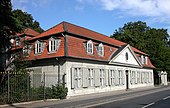Bebelhof (Braunschweig)
| District: | 132 - Viewegsgarten-Bebelhof |
| Residents: | 3970 (December 31, 2017) |
| Height: | 79 m above sea level NN |
| Post Code: | 38126 |
 Richmond Castle |
|
The Bebelhof and the Zuckerberg form a city quarter in the southeast of the core city of Braunschweig . The city quarter was created in the 1910s.
history
The Siemens plant for control and traffic technology is directly adjacent to the district . The complex was considered one of the most modern of its time and was renamed “Limbeker Hof” during the National Socialist era. It was a center of social democratic and communist sentiments in Braunschweig. More recently, attempts have been made to upgrade it as part of social urban redevelopment.
Bebelhof
The August-Bebel-Hof is a workers' housing complex built in the 1920s under the SPD state government near the train station. It is named after August Bebel . The settlement was in the immediate vicinity of the " Lämmchenteich " railway workers' settlement, which was started in 1926 and in which some buildings were built between 1927 and 1930 based on plans by Carl Mühlenpfordt . Like this one, the Bebelhof was built south of the marshalling yard on Salzdahlumer Straße. Most of the housing was built according to social aspects so that financially weaker sections of the population could also live in an appropriate quality. The orientation of the blocks was in a north-south direction. An architect and urban planner from Hamburg, Friedrich Richard Ostermeyer , therefore planned large open spaces between the rows of houses to ensure good ventilation of the apartments.
In the few buildings facing east-west, mostly communal facilities such as the kindergarten or parts of the administration were housed, but also a modern laundry room, which, according to a report in the Braunschweiger Zeitung from 1930, "aroused the envy of all housewives." an inn with meeting rooms, a library and a school were planned, but this was rejected because it was beyond the financial framework. The other political parties dubbed these social housing units as a “monument to red arrogance” and as a “disgusting mass gathering of Syrian caves”. The high unemployment at that time, however, meant that many apartments remained empty and so Gewobau had to file for bankruptcy as a property developer. In 1934 the settlement was foreclosed. In the late 1930s, the Bebelhof became a preferred residential area due to the improving economic situation.
That changed towards the end of World War II when more than 200 homes were destroyed. Reconstruction got off to a slow start at first, which only changed when the municipal Nibelungen Housing Association bought the complex in 1954 and began extensive renovation work in 1956. The former railway settlement “Lämmchenteich” has now been integrated into the term “Bebelhof”. In 1976 the railway repair shop was also closed.
Pile of sugar
The name Zuckerberg is derived from the sugar beet cultivation in this area. As early as 1769, the Brunswick Hereditary Prince Karl Ferdinand had the summer residence of Richmond Castle built here for his wife Augusta . Since she was the sister of King George III of England . it was given a large English-style garden that encompassed large parts of the sugar mountain.
In more recent times, the palace and park have been used by the city of Braunschweig, who owns it, for receptions, weddings and musical events. The former servants' house of the castle houses the Gerstäcker Museum , which commemorates the well-known writer Friedrich Gerstäcker and his travels with its exhibition .
Already after the First World War , the area on the Zuckerberg was divided into parcels and released for development. The central street was the "Zuckerbergweg", on which mostly one and two family houses with gardens were built. One of the buildings there was the home of the building contractor Karl Munte built in 1913 . It was acquired in 1929 by the city of Braunschweig, which used it as a guest house. From 1985 it stood empty for a while before it found a new use in 1997 as the "Klinik am Zuckerberg". Also in 1929, a Rollei factory was established on Zuckerbergweg . Despite the worldwide success of their photo technology products (especially cameras) it was closed in 1981. The former company premises and many of the associated buildings are still used by companies in various industries.
Attractions
- Richmond Castle and Gerstäcker Museum
- Braunschweig-Kolleg , former academy for youth leadership of the Hitler Youth (HJ)
- Wolters Brewery , old brewery from 1884
- Former Feldschlößchen brewery
- "Villa Schneider", today a state education center for the hearing impaired
Religions
- The Evangelical Martin Luther House is located on Zuckerbergweg.
The Catholic St. Godehard Church was built on the neighboring property to the east in 1962/63 . In 2009 it was profaned . The church building was demolished and a residential building was built on the property. Today the nearest Catholic church is 2 km away in the neighboring district of Heidberg .
Web links
- Bebelhof on braunschweig.de
- Zuckerberg on braunschweig.de
- Zuckerberg on strassenkatalog.de
Individual evidence
- ↑ Population statistics (Bebelhof and Zuckerberg) on braunschweig.de, accessed on July 29, 2018
- ↑ a b c History of the Bebelhof on braunschweig.de.
- ↑ a b c History of the Zuckerberg on braunschweig.de
Coordinates: 52 ° 15 ' N , 10 ° 32' E





